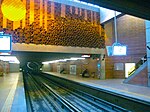Le Sanctuaire du Mont-Royal
Le Sanctuaire du Mont-Royal (also known as Le Sanctuaire) is a multi-phase condominium, commercial, athletic and medical complex located in the Côte-des-Neiges neighbourhood near the Outremont neighbourhood of Montreal, Quebec, Canada. The complex consists of seven phases (buildings), which contain a total of 925 residential units. Le Sanctuaire was built by Montreal-based luxury developer René Lépine Sr., head of Groupe Lépine.In total, the buildings amount to 139,355 square meters, which make them over 1.5 million square feet in size. The facades of the buildings are made of reinforced concrete. Construction officially started in 1981 and the buildings were completed in 1990. The project is considered by many to be an iconic modern Montreal landmark.
Excerpt from the Wikipedia article Le Sanctuaire du Mont-Royal (License: CC BY-SA 3.0, Authors).Le Sanctuaire du Mont-Royal
Place Northcrest, Montreal Côte-des-Neiges–Notre-Dame-de-Grâce
Geographical coordinates (GPS) Address Nearby Places Show on map
Geographical coordinates (GPS)
| Latitude | Longitude |
|---|---|
| N 45.5122 ° | E -73.6252 ° |
Address
Tour Highland
Place Northcrest 6280
H3S 2N1 Montreal, Côte-des-Neiges–Notre-Dame-de-Grâce
Quebec, Canada
Open on Google Maps







